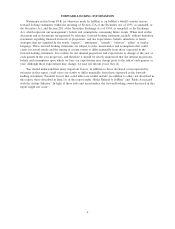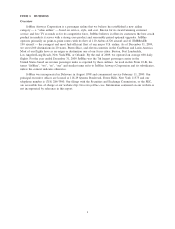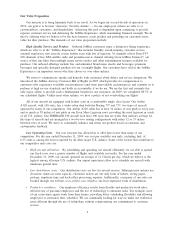JetBlue Airlines 2009 Annual Report Download - page 19
Download and view the complete annual report
Please find page 19 of the 2009 JetBlue Airlines annual report below. You can navigate through the pages in the report by either clicking on the pages listed below, or by using the keyword search tool below to find specific information within the annual report.closed from March 1 through June 30, 2010. While we believe the results of this project will ultimately help
to alleviate some of the challenges of operating at JFK, our operations may be adversely impacted during the
runway closure. In order to help mitigate the impact of this closure, the major domestic carriers operating at
JFK have agreed to reduce flights throughout the closure period.
At LaGuardia Airport, where we maintain a small presence, the High Density Rule was replaced by the
FAA with a temporary rule continuing the strict limitations on operations during the hours of 6:00 a.m. to
9:59 p.m. This rule had been scheduled to expire in late 2007 upon the enactment of a permanent rule
restructuring the rights of carriers to operate at LaGuardia. This final rule was issued in October 2008, but its
implementation has been partially stayed. Under the current rule, our operations remain unaffected. Should
new rules be implemented in whole or in part, our ability to maintain a full schedule at LaGuardia would
likely be impacted.
Long Beach (California) Municipal Airport is a slot-controlled airport as a result of a 1995 court
settlement. Under the settlement, there are a total of 41 daily non-commuter departure slots and a single slot is
required for every commercial departure. There are no plans to eliminate slot restrictions at the Long Beach
Municipal Airport. In April 2003, the FAA approved a settlement agreement among the City of Long Beach,
American Airlines, Alaska Airlines and JetBlue with respect to the allocation of the slots. This settlement
provides for a priority allocation procedure should supplemental slots above the 41 current slots become
available. We have 29 slots available for use and currently operate 30 weekday roundtrip flights from Long
Beach Municipal Airport to 14 domestic cities.
Environmental. We are subject to various federal, state and local laws relating to the protection of the
environment, including the discharge or disposal of materials and chemicals and the regulation of aircraft
noise administered by numerous state and federal agencies.
The Airport Noise and Capacity Act of 1990 recognizes the right of airport operators with special noise
problems to implement local noise abatement procedures as long as those procedures do not interfere
unreasonably with the interstate and foreign commerce of the national air transportation system. Certain
airports, including San Diego and Long Beach, California, have established restrictions to limit noise which
can include limits on the number of hourly or daily operations and the time of such operations. These
limitations serve to protect the local noise-sensitive communities surrounding the airport. Our scheduled flights
at Long Beach and San Diego are in compliance with the noise curfew limits but when we experience
irregular operations, on occasion, we violate these curfews. We have agreed to a payment structure with the
Long Beach City Prosecutor for any violations which we pay quarterly to the Long Beach Public Library
Foundation and are based on the number of infractions in the preceding quarter. This local ordinance has not
had, and we believe that it will not have, a negative effect on our operations.
We have launched a “Jetting to Green” program on www.jetblue.com, which we use to educate our
customers and crewmembers about environmental issues and to inform the public about our “green” initiatives.
We have also published a corporate sustainability report, which addresses our environmental programs,
including those aimed at curbing greenhouse gas emissions, our conservation efforts and our social
responsibility initiatives.
In December 2009, we signed comprehensive memorandums of understanding, along with 14 other
airlines, with two different producers for a future supply of alternative aviation fuel, which would be more
environmentally friendly than jet fuel currently being used. One producer, AltAir Fuels, plans for the
production of approximately 75 million gallons per year of jet fuel and diesel fuel derived from camelina oils
or comparable feedstock. The other producer, Rentech, plans for the production of approximately 250 million
gallons per year of synthetic jet fuel derived principally from coal or petroleum coke.
Foreign Operations. International air transportation is subject to extensive government regulation. The
availability of international routes to U.S. carriers is regulated by treaties and related agreements between the
United States and foreign governments. We currently operate international service to The Bahamas, the
Dominican Republic, Bermuda, Aruba, the Netherlands Antilles, Mexico, Colombia, Costa Rica, Jamaica,
Barbados, and Saint Lucia. To the extent we seek to provide air transportation to additional international
10
























